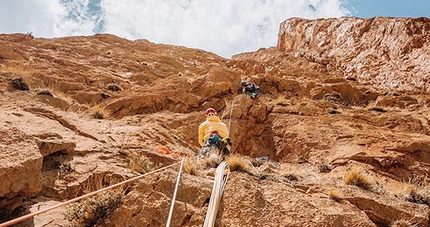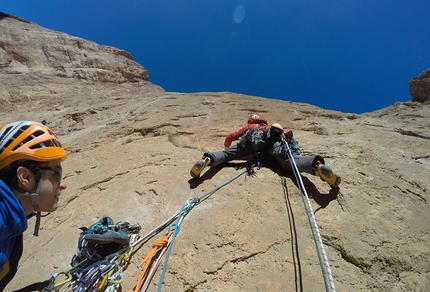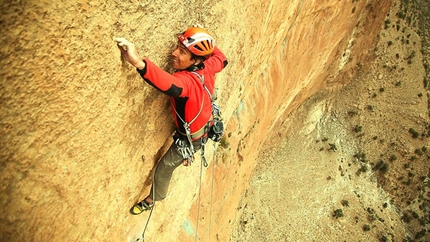‘Kairos’ multipitch added to Taghia (Morocco) by Davide Gaeta, Gabriele Gorobey, Guido De Sabbata

 1 / 38
1 / 38 archivio Gaeta, Gorobey, De Sabbata
archivio Gaeta, Gorobey, De Sabbata
Another small vertical adventure, similar probably to so many others but, for us, absolutely unique, like every moment we experienced during these intense days in Morocco. I will try to tell you about the process that led to us establishing this new climb, the doubts we had, the effort we put in and our constant battle against time...
It's the end of 2022, Davide Gaeta and I have started to think about a climbing trip abroad and although we fix the dates almost immediately, since the departure is at the start of March 2023, we've still got plenty of confused ideas. This time we both desire a slightly different experience. I personally want to get back into establishing something ground-up, after a long period away from this game, for various reasons. At the same time, we're both conscious of the fact that we want to experience something which is culturally, historically and environmentally completely different from what we are used to. Our goal is to go somewhere that offers more than just climbing, leading us to conclude that as the years pass, we're becoming more profound. Or simply just older!
I'm the one who initially suggests Taghia in Morocco. It's just one of my many ideas, but although I've never been before, I know for certain it's worth a trip. Quite quickly though we eliminate it from the list, discouraged by the fact that it's already been visited by so many other climbers. While we continue to evaluate new options, Guido De Sabbata joins us on this aimless project. The three of us are very different, but we're close-knit and great friends and have already been on several climbing trips together. We're certainly a good team.
All throughout January we continue to send each other countless ideas, but towards the end of the month we need to make a decision once and for all and proceed with organising the trip. I'm in Argentina with my girlfriend when Davide writes to me saying that, considering the costs and the limited time available, Taghia seems to be the best choice. Early March seems too early for conditions to be decent, but it also seems as if it hasn't snowed much this year so we decide to give it a shot. We'd like to forge a new route, which perhaps would not be the most obvious thing to do, given that the most obvious lines have all already been taken, but in truth we're open to everything, even "just" repeating the climbs that have made this place so famous.
Two days to go before our departure and the weather looks disastrous, snow and storms are on the way. Mohamed, the owner of the gite where we are supposed to stay, sends us photos and discouraging news, the entire area is blanketed in 30 cm of snow. The temperatures are well below zero and Mohamed writes "it will be good for climbing from 20th March". I immediately think that we should have expected this and feel a bit of an idiot. Eventhough we're supposed to leave early the next morning, we're almost at the point of changing destination at the very last minute; we are undecided and distressed. However, the latest forecast indicates that the weather will actually improve. Unconvinced,I remain worried and fear that the melting snow will make the walls seep for a long time. But by now we're in the game. We make some changes to our gear and stuff loads of thermal base layers, down sleeping bags and warmer clothes into our haulbags.
After a long journey we reach Taghia at lunchtime on the 2nd of March. There is a lot of snow, it's cold, the walls are dark and wet, but we're simply too motivated to stay put and so we immediately make our way into the canyon. In ecstasy we scout below legendary climbs such as Axe du Mal, Sul Filo della Notte and La Gran Rouge. At times the snow is knee-deep. The ledges are covered in snow and the walls are filled with spindrift. Needless to say, we are obviously the only climbers in all of Taghia! Who else would be so stupid? We explore the canyon for several hours and then return to Mohamed's gite. Tomorrow we'll go to Paroi de la Cascade, a shotyrr wall located above the village. Having carefully studied previous reports and the guidebooks, even before getting to Morocco we knew that in the case of poor conditions, this wall might become our plan B.
The next morning Davide and I have breakfast and scramble up to the wall. When we arrive below the Cascade, I immediately realise that I've seen far worse plan Bs! Admittedly the wall is not as impressive as the others in the area, but the quality of the rock galvanises us. The section of the face we'd studied carefully before leaving Italy is wet, but on closer inspection we notice some tufas that always remain dry, suspended way higher up, so we start imagining a line that might somehow reach them. The more we study the face through our binoculars, the more we start to like the idea. All things considered it seems like the best option, we feel that this line is calling us. We look at each other and smile. We both feel it's right. We rush down to the village, grab the drill and walk back up with our backpacks fully loaded. If we're quick, we've got another two hours of daylight...
We decide to traverse across the large ledge and skip what could be the first pitch, and so we start establishing the second. Dave gets the ball rolling, then I take over and reach two large pockets where I decide to make a belay. What we've just climbed isn't hard but it's really beautiful, and from my new vantage point I can finally observe those tufas that we'd glimpsed from below. They seem fantastic but not easy. It's dark now, and so we descend and reach Guido at the gite, eager to tell him everything about our day.
I spend the night thinking, still unsure about what we’ve just done. I can’t sleep; perhaps I acted too impulsively. And Davide, ironically nicknamed "excess enthusiasm" for some time now, may have infected me with his boundless positivity. I feel like we have little time, and I don’t want to waste any more of it. Yet, I felt a spark, and usually my instinct isn't wrong. The thought that the sun will be out tomorrow keeps me awake - maybe the canyon will become more accessible, making it possible to open the line I was looking at, more vertical and longer than the one we’ve just started. In the end, though I convince myself that, given the current conditions, it’s wiser to stay put, in the sun and closer to the village. Finally, dawn breaks and my companions wake up too. I can't wait to share my thoughts and doubts with them. Davide looks at me and smiles; he knows me and understands my restlessness. "Don’t worry" he says, "we'll go back to the route and then we’ll see!"
The three of us ascend to our previous highpoint and are faced with a dilemma.To our left, there’s a spectacular and seemingly easier section, but it’s wet. Above us, there’s the line we saw the day before on the dark tufas. After some discussion, we decide what to do. I start on the tufas to the right, and after moving across some incredible holds, I soon find myself on a dry boulder crux with a fairly morpho move. I climb with difficulty, cleaning the holds, clipping, and placing a bolt. This pitch, I think to myself, will be complicated to free. Guido takes over, full of energy—he’d been chomping at the bit below, waiting for his moment to finally unleash his strength on the untouched holds.
Another day flies by; we’ve made some progress, though not by much. The rock is beautiful, but the first time you grab the holds, you feel tiny spikes and coral-like textures digging into your fingertips, breaking under your feet. All this makes ground-up bolting more complicated and slower. However, we quickly realise that once the holds are brushed, they’re truly incredible. We’re not moving very fast, but ours is ia small symphony played by six hands, and each of us wants to play their part.
After breaching the main difficulties, we find ourselves dealing with incredibly hard rock, which causes some issues with the drill bits. And so we need another day to finish the route, aftwr following a very beautiful pillar a few dozen meters to the right of our intended line. Finally, we exit the wall and race to the top for the ritual summit selfie, dirty and tired but on cloud nine.
Bolting a route always "stresses" me out because I feel like I need to do something for myself but especially for others; I care about leaving the climb as impeccable as possible. Still, I trust my partners, who feel the same sense of duty—they’re excellent climbers who know how to read the rock and make the right decisions. So, we carefully clean the route and decide to add a few bolts where the runouts are too long. The route is so beautiful that we want to give it our very best, so that it gets repeated in the future. Only the first pitch now remains to be done, the one below the ledge we traversed on day 1..
The weather is always splendid; the sun does its job, the snow slowly disappears and the walls are drying out more and more. These are really good conditions. So, our spirits shift from the initial idea of not being able get any climbing done at all, overwhelmed and discouraged, to the idea of never resting! The following day, on what should have been a "rest day," we decide to go into the canyon, bivouac there, and wait for the morning to repeat a spectacular route on truly incredible rock, Axe du Mal. Although we don’t make it to the top, we spend hours exploring the dizzying walls of this untouched corner of nature.
By Thursday, we’re starting to feel the fatigue, but there’s no time to lose and we have to make the most of every moment. We return to our route and decide to bolt the first pitch from above. We’ve never done this on a multi-pitch before, but now it seems like a wise decision because we’re really short on time. The pitch looks complex, and we need to clean the rock thoroughly. The ledge above is easily accessible on foot, plus the usual short traverse we’ve been repeating for days. On the Cascade wall there are three other lines, and among the first ascensionists are notable names like Petit, Oddo, and Hemetzberger. The latter, on Tabula Rasa, had made the same decision to bolt the first pitch from above.
But without making excuses, it seems logical to us, and we simply don’t have the time to do it differently. So, we bolt and clean this first pitch, which is truly fantastic—it starts on an overhang marked by a beautiful tufa and then moves into a physical overhang on decent holds. In the end, it turns out to be the pitch with the most bolts, but this is consistent with the choice to bolt it from above.
The last two days arrive; the route is ready and cleaned. All that’s left is to attempt the free ascent. Meanwhile, the weather has definitely changed—we’re forced to wait until 3:00 PM to find climbing conditions, as it’s too hot otherwise, and our skin is already worn out. We also decide to sleep near the wall, hoping to climb early on Saturday morning, the last usable day of the trip. However, the next day it’s still too hot, and we have no choice but to wait until the afternoon again. As a result, we reach the top just before darkness falls, but we’re satisfied with having freed all the individual pitches.
At the end of a trip where everything could have gone wrong, we’re happy that, with a bit of luck and a lot of accumulated effort, we’ve managed to open a beautiful route. The only thing missing is the full free ascent, but this time there really wasn’t enough time. We leave Taghia in intense heat, with no more snow on the walls but with the certainty of having done a good job and something to be proud of. We hadn’t imagined such a line, but in the end, everything fell into place, every piece fit, and once again, "one way or another," the puzzle is complete. Determination and a pinch of luck are always essential ingredients. We had fun, strengthened our team chemistry, and even before the end of these days, we were already discussing new projects.
The suggested grades, we hope, are accurate and are the result of discussions in the frenzy of these days, and of course, we await repeats. To conclude, I’ll talk about the route’s name. We wanted to dedicate it to the donkeys that accompanied us these days, keeping us company with their unmistakable braying echoing throughout the valley. But then Guido, reflecting on how much attention we’d focused on Time, came up with Kairos. The term comes from the ancient Greeks, who, with their renowned wisdom, coined multiple terms to indicate different concepts of time. Among them, Kairos is the "right moment," that immeasurable instant when something special happens. Whether it was found through the trio’s perseverance or a stroke of luck is undeniable, but in any case, it perfectly captures what these days have meant for us.



 Copia link
Copia link

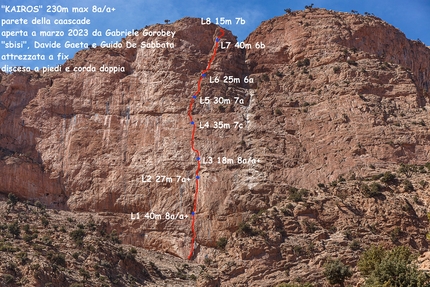
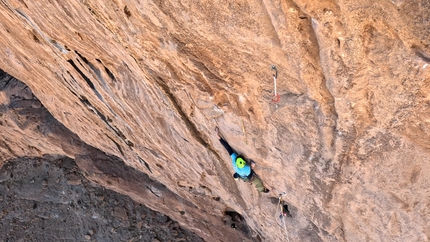
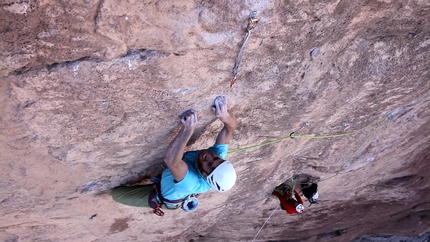
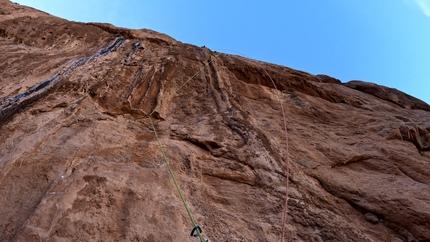
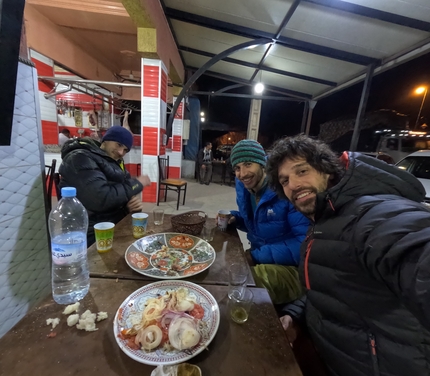
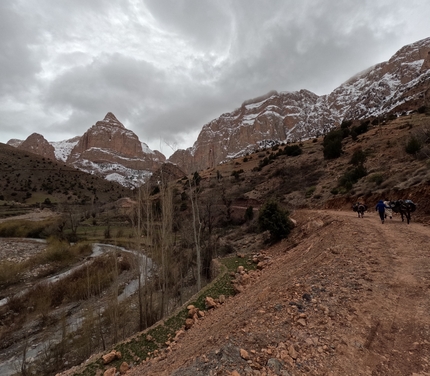
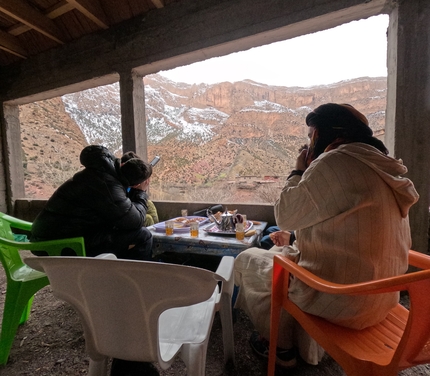
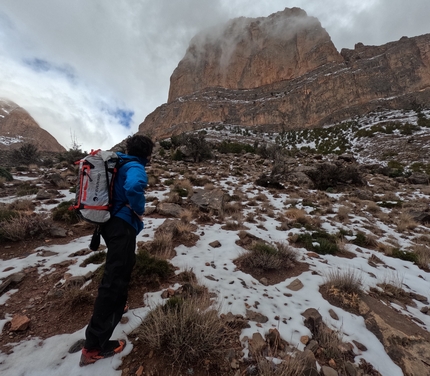
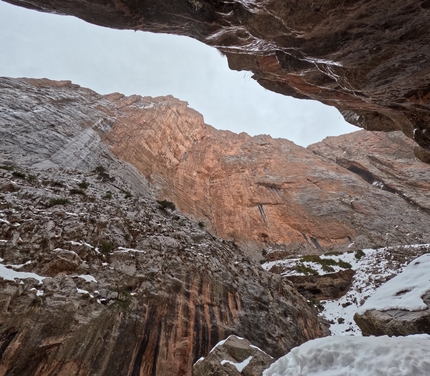
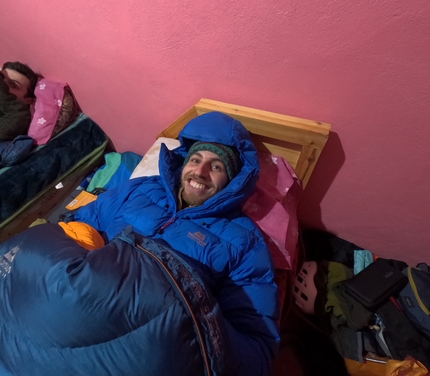
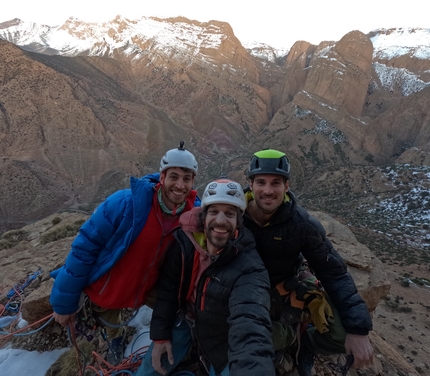
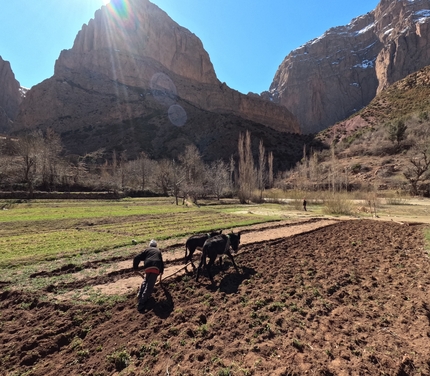
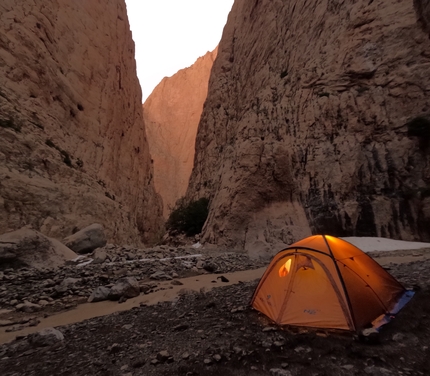
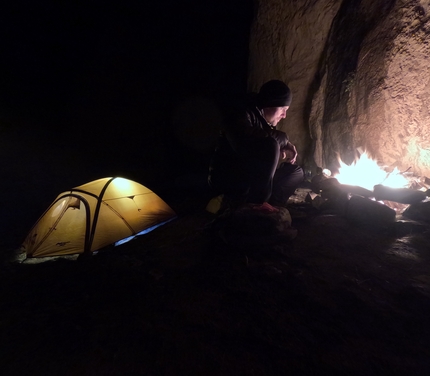
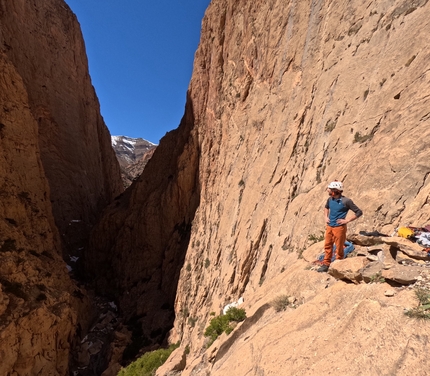

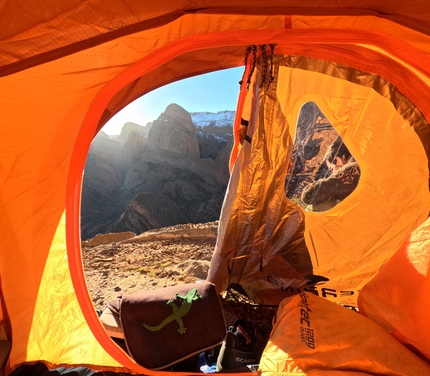
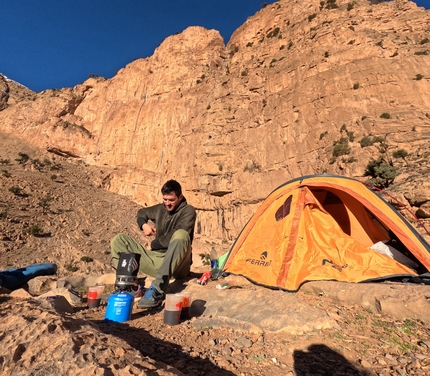
 See all photos
See all photos